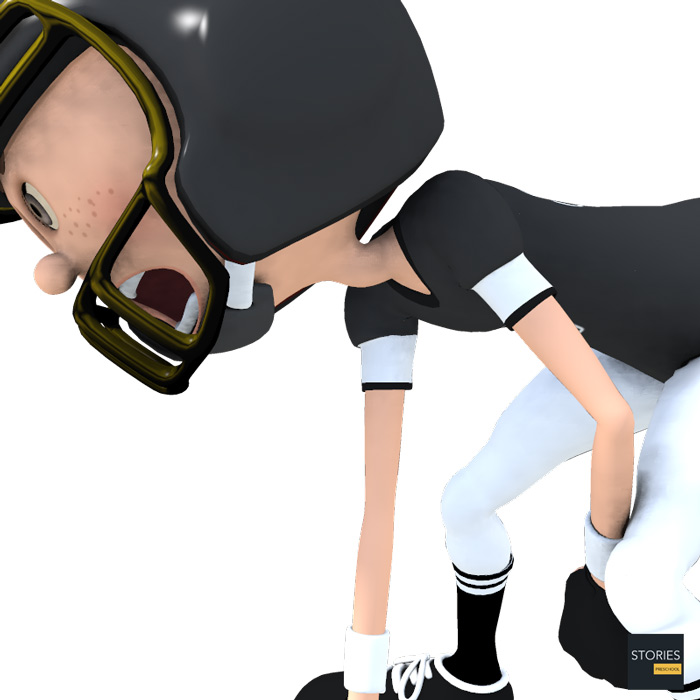American football

Defensive Tackle (DT)
A defensive tackle (DT) is typically the largest and strongest of the defensive players in American football. The defensive tackle typically lines up opposite one of the offensive guards. Depending on a team's individual defensive scheme, a defensive tackle may be called upon to fill several different roles. These roles may include merely holding the point of attack by refusing to be moved or penetrating a certain gap between offensive linemen to break up a play in the opponent's backfield. If a defensive tackle reads a pass play, his primary responsibility is to pursue the quarterback, or simply knock the pass down at the line if it's within arm's reach. Other responsibilities of the defensive tackle may be to pursue the screen pass or drop into coverage in a zone blitz scheme. In a traditional 4–3 defensive set, there is no nose tackle. Instead there is a left and right defensive tackle. Some teams especially in the NFL do have a nose tackle in this scheme, but most of them do not.

Nose tackle
Nose tackle (also nose guard or middle guard) is a defensive alignment position for a defensive lineman. In the 3–4 defensive scheme the sole defensive tackle is referred to as the nose tackle. The nose tackle aligns across the line of scrimmage from the offense's center before the play begins in the "0-technique" position. In this position, frequently taking on the center and at least one if not both of the guards, the nose tackle is considered to be the most physically demanding position in football. In five-linemen situations, such as a goal-line formation, the nose guard is the innermost lineman, flanked on either side by a defensive tackle or defensive end. According to Pat Kirwan, a traditional 3–4 defense demands "a massive man who can clog up the middle," while a 4–3 defense is looking for "a nose tackle who relies on quickness to penetrate and move along the front."
Typical 3–4 nose tackles are "big wide bodies who can hold the point of attack and force double teams by the guard and center." They are usually the heaviest players on the roster, with weights ranging from 325 to 375 pounds (147 to 170 kg). Also, height is critical, as they are supposed to get "under" the offensive line, which means ideal 3–4 nose tackles are no taller than 6 ft 3 in (1.91 m). Recent examples of such nose tackles include Ron Simmons, Casey Hampton, Jamal Williams, Gilbert Brown, and Vince Wilfork. Rather uncommon are taller nose tackles, such as Ted Washington and Ma'ake Kemoeatu, who each won a Super Bowl ring are both 6 ft 5 in (1.96 m) tall.
In some 4–3 defensive set, the nose tackle is one of two defensive tackles. Some teams especially in the NFL do have a nose tackle in the 4–3 defensive set, which lines up against the opposing center and very likely the weak-side or pulling guard. In a 4–3 defensive set, nose tackles are rather quick and supposed to "shoot the 'A gap' and beat the center and very likely the weak-side or pulling guard into the backfield." Height is not as important, and their weight is closer to 300 pounds (136 kg).
The terms "nose guard" or "middle guard" were more commonly used with the five-man defensive line of the older 5-2 defense. Effective against most plays of the day, but with a weakness to the inside short pass, the 5–2 was phased out of the pro game in the late 1950s. In the 4-3 defense, the upright middle linebacker replaced the middle guard. The nose guard is also used in a 50 read defense. In this defense there is a nose guard, two defensive tackles, and two outside linebackers who can play on the line of scrimmage or off the line of scrimmage in a two-point stance. The nose guard lines up head up on the center about six to eighteen inches off the ball. In a reading 50 defense, the nose guard's key is to read the offensive center to the ball. In run away, the nose guard's job is to shed the blocker and pursue down the line of scrimmage, taking an angle of pursuit. The primary responsibility of the nose tackle in this scheme is to absorb multiple blockers so that other players in the defensive front can attack ball carriers and rush the quarterback.
SPORTS



American Football
Game play in American football consists of a series of downs, individual plays of short duration, outside of which the ball is dead or not in play. These can be plays from scrimmage – passes, runs, punts, or field goal attempts (from either a place kick or a drop kick) – or free kicks such as kickoffs and fair catch kicks. Substitutions can be made between downs, which allows for a great deal of specialization as coaches choose the players best suited for each particular situation. During a play, each team should have no more than 11 players on the field, and each of them has specific tasks assigned for that specific play.
Rules and gameplay
- Scoring
- Maneuvers
- Strategy
- Play types
- Penalties
- Turnovers
- Downs
- Teams and positions
- Field
- Equipment
- Duration and time stoppages
- Advancing the ball and downs
- Kicking
- Officials and fouls
Positions
Offensive (Interior) line
Backs and receivers
Defensive line
Linebackers
Defensive backs
Special teams
- Kicker (K)
- Holder (H)
- Long snapper (LS)
- Punter (P)
- Kickoff specialist (KOS)
- Kick returner (KR) and Punt returner (PR)
- Upback
- Gunner
- Jammer


RESOURCES
This article uses material from the Wikipedia articles "American football", "American football positions" and "Defensive tackle", which is released under the Creative Commons Attribution-Share-Alike License 3.0.
© Stories Preschool. All Rights Reserved.





